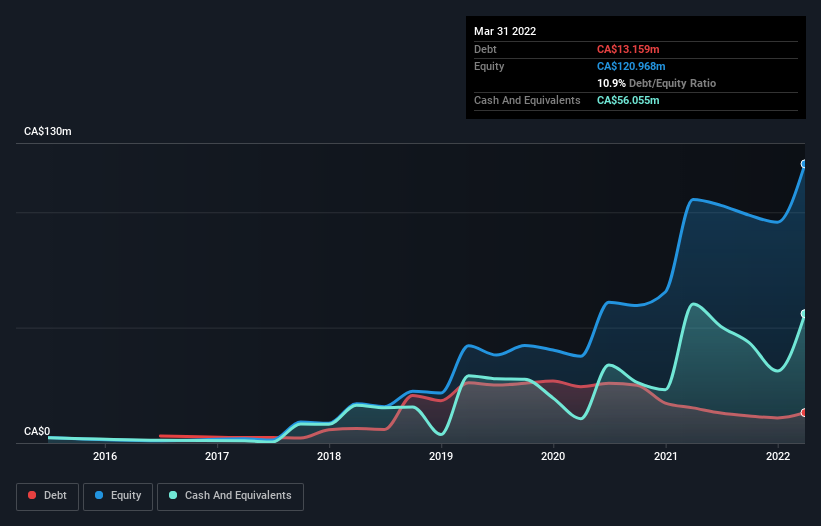NanoXplore (TSE:GRA) Has Debt But No Earnings; Should You Worry?
Some say volatility, rather than debt, is the best way to think about risk as an investor, but Warren Buffett famously said that 'Volatility is far from synonymous with risk.' When we think about how risky a company is, we always like to look at its use of debt, since debt overload can lead to ruin. As with many other companies NanoXplore Inc. (TSE:GRA) makes use of debt. But should shareholders be worried about its use of debt?
When Is Debt A Problem?
Debt and other liabilities become risky for a business when it cannot easily fulfill those obligations, either with free cash flow or by raising capital at an attractive price. Ultimately, if the company can't fulfill its legal obligations to repay debt, shareholders could walk away with nothing. However, a more usual (but still expensive) situation is where a company must dilute shareholders at a cheap share price simply to get debt under control. By replacing dilution, though, debt can be an extremely good tool for businesses that need capital to invest in growth at high rates of return. When we examine debt levels, we first consider both cash and debt levels, together.
See our latest analysis for NanoXplore
How Much Debt Does NanoXplore Carry?
As you can see below, NanoXplore had CA$13.2m of debt at March 2022, down from CA$15.2m a year prior. However, its balance sheet shows it holds CA$56.1m in cash, so it actually has CA$42.9m net cash.

How Healthy Is NanoXplore's Balance Sheet?
According to the last reported balance sheet, NanoXplore had liabilities of CA$26.8m due within 12 months, and liabilities of CA$21.8m due beyond 12 months. On the other hand, it had cash of CA$56.1m and CA$19.1m worth of receivables due within a year. So it actually has CA$26.6m more liquid assets than total liabilities.
This surplus suggests that NanoXplore has a conservative balance sheet, and could probably eliminate its debt without much difficulty. Simply put, the fact that NanoXplore has more cash than debt is arguably a good indication that it can manage its debt safely. There's no doubt that we learn most about debt from the balance sheet. But it is future earnings, more than anything, that will determine NanoXplore's ability to maintain a healthy balance sheet going forward. So if you want to see what the professionals think, you might find this free report on analyst profit forecasts to be interesting.
In the last year NanoXplore wasn't profitable at an EBIT level, but managed to grow its revenue by 46%, to CA$85m. Shareholders probably have their fingers crossed that it can grow its way to profits.
So How Risky Is NanoXplore?
Statistically speaking companies that lose money are riskier than those that make money. And the fact is that over the last twelve months NanoXplore lost money at the earnings before interest and tax (EBIT) line. And over the same period it saw negative free cash outflow of CA$24m and booked a CA$17m accounting loss. With only CA$42.9m on the balance sheet, it would appear that its going to need to raise capital again soon. With very solid revenue growth in the last year, NanoXplore may be on a path to profitability. Pre-profit companies are often risky, but they can also offer great rewards. When analysing debt levels, the balance sheet is the obvious place to start. But ultimately, every company can contain risks that exist outside of the balance sheet. Case in point: We've spotted 3 warning signs for NanoXplore you should be aware of, and 1 of them makes us a bit uncomfortable.
At the end of the day, it's often better to focus on companies that are free from net debt. You can access our special list of such companies (all with a track record of profit growth). It's free.
Mobile Infrastructure for Defense and Disaster
The next wave in robotics isn't humanoid. Its fully autonomous towers delivering 5G, ISR, and radar in under 30 minutes, anywhere.
Get the investor briefing before the next round of contracts
Sponsored On Behalf of CiTechValuation is complex, but we're here to simplify it.
Discover if NanoXplore might be undervalued or overvalued with our detailed analysis, featuring fair value estimates, potential risks, dividends, insider trades, and its financial condition.
Access Free AnalysisHave feedback on this article? Concerned about the content? Get in touch with us directly. Alternatively, email editorial-team (at) simplywallst.com.
This article by Simply Wall St is general in nature. We provide commentary based on historical data and analyst forecasts only using an unbiased methodology and our articles are not intended to be financial advice. It does not constitute a recommendation to buy or sell any stock, and does not take account of your objectives, or your financial situation. We aim to bring you long-term focused analysis driven by fundamental data. Note that our analysis may not factor in the latest price-sensitive company announcements or qualitative material. Simply Wall St has no position in any stocks mentioned.
About TSX:GRA
NanoXplore
A graphene company, manufactures and supplies graphene powder for use in transportation and industrial markets in Australia.
Flawless balance sheet with high growth potential.
Similar Companies
Market Insights
Weekly Picks

Early mover in a fast growing industry. Likely to experience share price volatility as they scale


A case for CA$31.80 (undiluted), aka 8,616% upside from CA$0.37 (an 86 bagger!).


Moderation and Stabilisation: HOLD: Fair Price based on a 4-year Cycle is $12.08
Recently Updated Narratives


Title: Market Sentiment Is Dead Wrong — Here's Why PSEC Deserves a Second Look


An amazing opportunity to potentially get a 100 bagger

Amazon: Why the World’s Biggest Platform Still Runs on Invisible Economics
Popular Narratives


Crazy Undervalued 42 Baggers Silver Play (Active & Running Mine)


MicroVision will explode future revenue by 380.37% with a vision towards success


NVDA: Expanding AI Demand Will Drive Major Data Center Investments Through 2026
Trending Discussion


